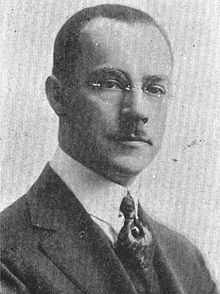Edward P. Kimball
| Edward P. Kimball | |
|---|---|
 | |
| Personal details | |
| Born | Edward Partridge Kimball June 2, 1882 Salt Lake City, Utah Territory, United States |
| Died | March 15, 1937 (aged 54) District Of Columbia, United States |
| Resting place | Salt Lake City Cemetery |
| Known For | Organist or assistant organist of the Mormon Tabernacle Choir from 1905 to 1937 |
| Spouse(s) | Hazel Y. Beaties |
| Children | 3 |
| Parents | Albert K. Kimball<Harriet Partridge |
Edward Partridge Kimball (June 2, 1882[1] – March 15, 1937) was an American organist of the Mormon Tabernacle Choir and a Latter-day Saint hymn writer.
In 1898 Kimball was appointed music teacher at the Beaver Branch of Brigham Young Academy. From April 11, 1902 to April 1906, Kimball served as a missionary for The Church of Jesus Christ of Latter-day Saints (LDS Church) in Germany.[1]
Kimball was either the organist or assistant organist of the Mormon Tabernacle Choir from 1905 to 1937.[2] Kimball was the organist when Music and the Spoken Word was begun.[3] His son, Ted Kimball, was the first announcer for the show.
Kimball wrote the words to "God Loved Us, So He Sent His Son" and the music to "Great God, To Thee My Evening Song" and "The Wintry Day Descending to a Close", all of which are in the 1985 English language edition of the LDS Church hymnal.
Kimball took a leave from his active service as Mormon Tabernacle organist to serve as president of the LDS Church's German–Austrian Mission.[1][4]
In 1933, Kimball was appointed organist and director of the church's Bureau of Information in Washington, D. C., where he also served as a lecturer and guide. While in this role, Kimball died following a brief illness in 1937.[5]
References
- ^ a b c Jenson, Andrew (1936). Latter-day Saint biographical encyclopedia: A compilation of biographical sketches of prominent men and women in The Church of Jesus Christ of Latter-Day Saints. Vol. 4. Salt Lake City, Utah: The Andrew Jenson History Company (Printed by The Deseret News Press). pp. 216 & 338. Retrieved February 25, 2014.
- ^ Miller, Roger L. (1994), "Mormon Tabernacle Choir", in Powell, Allan Kent (ed.), Utah History Encyclopedia, Salt Lake City, Utah: University of Utah Press, ISBN 0874804256, OCLC 30473917, archived from the original on 2017-01-13, retrieved 2013-10-30
- ^ Jackson, Lisa Ann (July 2004). "From the Crossroads of the West". Ensign. Salt Lake City, Utah: The Church of Jesus Christ of Latter-day Saints. Retrieved 25 February 2014.
- ^ Edward P. Kimball, "Remarks", Conference Report, Oct. 1930.
- ^ Grant, Heber J.; Widtsoe, John A.; Josephson, Marba C., eds. (April 1937). "The Church Moves On: Edward P. Kimball passes". Improvement Era. 40 (4). The Church of Jesus Christ of Latter-day Saints. Retrieved 25 February 2014.
- 1882 births
- 1937 deaths
- 20th-century Mormon missionaries
- 20th-century classical musicians
- American Latter Day Saint hymnwriters
- American Mormon missionaries in Austria
- American Mormon missionaries in Germany
- American leaders of the Church of Jesus Christ of Latter-day Saints
- American male organists
- Brigham Young Academy faculty
- Mission presidents (LDS Church)
- Tabernacle Choir organists
- 20th-century American male musicians
- Male classical organists
- American organists
